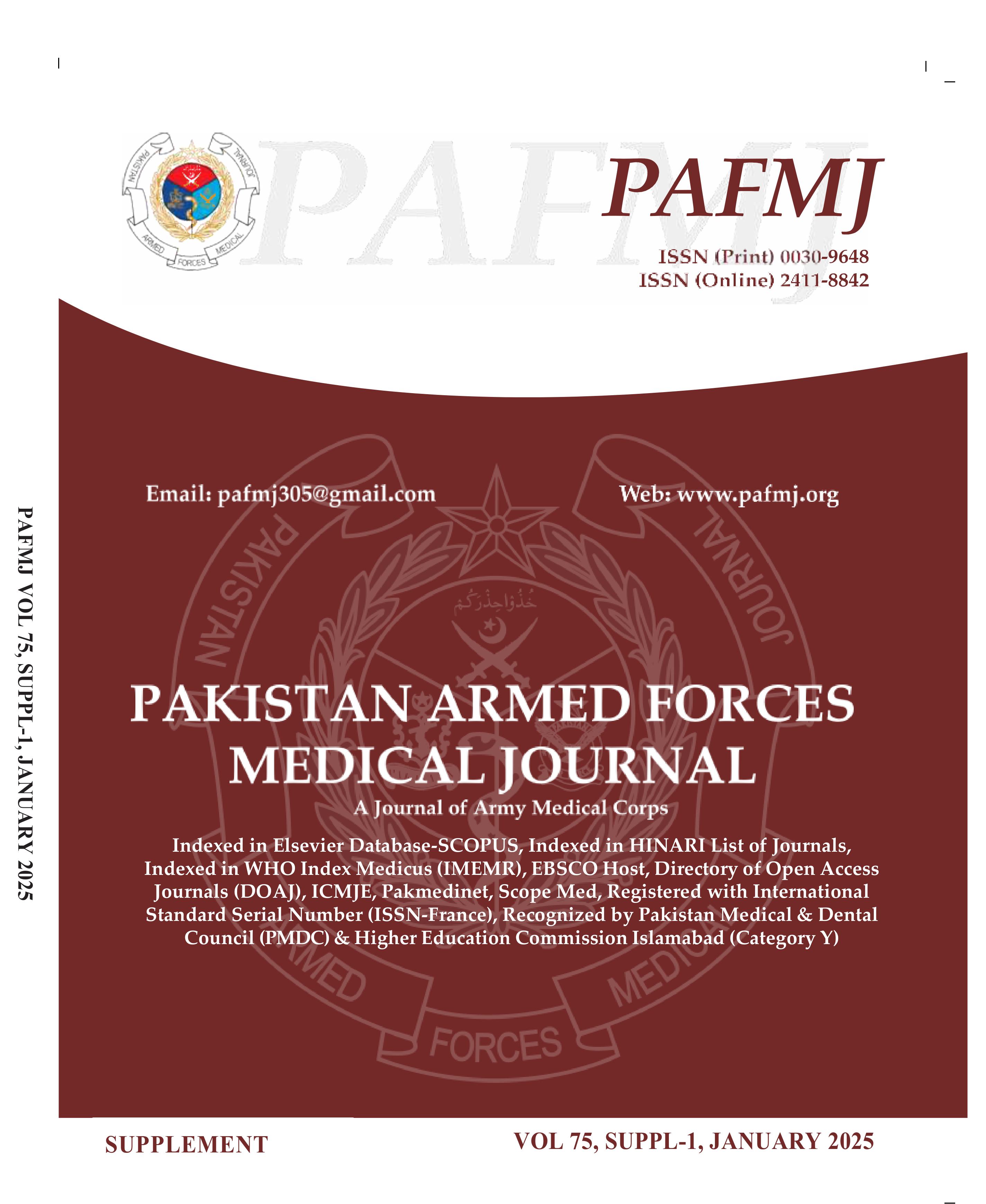Comparison of Intravenous Lidocaine versus Dexmedetomidine on Postoperative Pain and Analgesic Consumption after Gynecological Abdominal Surgery
DOI:
https://doi.org/10.51253/pafmj.v75iSUPPL-1.11629Keywords:
Analgesia, Dexmedetomidine, Gynecological surgery, Lidocaine, Post-operative pain,Visual analogue score.Abstract
Objectives: To determine the analgesic efficacy of intravenous dexmedetomidine versus lidocaine for post-operative pain in patients undergoing abdominal gynaecological surgeries.
Study Design: Quasi experimental study
Place and Duration of Study: Department of Anesthesia/Pain Medicine, Combined Military Hospital Lahore from May 2023 – October 2023.
Methodology: Sixty patients undergoing gynaecological surgeries under general anaesthesia were included in the study. Patients in Group D were given intraoperative dexmedetomidine while those in Group L were given lidocaine. The primary outcome was the pain score measured by the Visual analogue score at three, six, twelve and twenty fours following the procedure. The secondary outcome was the amount of tramadol in milligrams that was consumed for pain relief.
Results: In both groups, the mean pain score remained 5 or less over 24 hours. Median(IQR) pain score after 3 hour was 3(2) in Group D while it was 3(2) in Group L. After 6 hours it was recorded as 4(2) in Group D and 4(3) in Group L. At 12 hours it was recorded as 3.5(2.25) in Group D and 4(3) in Group L. Last reading was taken 24 hours after the procedure and it showed a mean pain score of 4(2.5) in Group D and 4(3) in Group L. Total mean Tramadol consumption in group D was 121.67±67.83 mg and 132.5±62.68 mg in Group L.
Conclusion: In conclusion, both drugs are equally effective in the management of post-operative pain in the first 24 hours of gynecoloical surgery.
Downloads
References
O'Neill A, Lirk P. Multimodal Analgesia. Anesthesiol Clin. 2022 Sep;40(3):455-468. http://doi: 10.1016/j.anclin.2022.04.002.
Lv X, Zhang H, Gao J, Hou A, Ma Y, Zhou Z, Mi W, Zhang H, Liu Y. Intraoperative dexmedetomidine on postoperative pain in gastrointestinal surgery: an observational study. Int J Surg. 2023 Apr 1; 109(4): 887-895. http://doi: 10.1097/JS9.0000000000000360.
Shanthanna H. Risk factors and prediction modelling for chronic post-surgical pain after breast cancer surgery. Anaesthesia. 2023 Jul; 78(7): 811-815. http://doi: 10.1111/anae.16011.
Xuan C, Yan W, Wang D, Li C, Ma H, Mueller A, Chin V, Houle TT, Wang J. Efficacy of preemptive analgesia treatments for the management of postoperative pain: a network meta-analysis. Br J Anaesth. 2022 Dec; 129(6): 946-958. http://doi: 10.1016/j.bja.2022.08.038.
Qin P, Wei K, Yang Q, Zhu Y, Zheng X, Zhang H. Effect of lidocaine or dexmedetomidine on postoperative recovery in elder patients undergoing colorectal surgery. Minerva Anestesiol. 2023 May; 89(5): 405-414. http://doi: 10.23736/S0375-9393.23.17099-4.
Yang X, Wei X, Mu Y, Li Q, Liu J. A review of the mechanism of the central analgesic effect of lidocaine. Medicine (Baltimore). 2020 Apr; 99(17): e19898. http://doi: 10.1097/MD.0000000000019898.
Tang C, Xia Z. Dexmedetomidine in perioperative acute pain management: a non-opioid adjuvant analgesic. J Pain Res. 2017 Aug 11; 10: 1899-1904. http://doi: 10.2147/JPR.S139387.
8.Kranke P, Jokinen J, Pace NL, Schnabel A, Hollmann MW, Hahnenkamp K, et al. Continuous intravenous perioperative lidocaine infusion for postoperative pain and recovery. Cochrane Database Syst Rev 2015;7:CD00964.
Basantwani S, Patil M, Govardhane B, Magar J, Tendolkar B. Effect of dexmedetomidine infusion on hemodynamic responses in microsurgery of larynx. J Anaesthesiol Clin Pharmacol 2018 ;34: 51–7.
Lundorf LJ, Nedergaard HK, Møller AM. Perioperative dexmedetomidine for acute pain after abdominal surgery in adults. Cochrane Database of Systematic Reviews. 2016(2).
Sivaji P, Agrawal S, Kumar A, Bahadur A. Evaluation of lignocaine, dexmedetomidine, lignocaine-dexmedetomidine infusion on pain and quality of recovery for robotic abdominal hysterectomy: a prospective randomized controlled trial. Brazilian Journal of Anesthesiology. 2022 Oct 10; 72:593-8.
Kim DJ, Bengali R, Anderson TA. Opioid-free anesthesia using continuous dexmedetomidine and lidocaine infusions in spine surgery. Korean journal of anesthesiology. 2017 Dec 1; 70(6): 652-3].
Modir H, Yazdi B, Talebi H, Eraghi MG, Behrouzi A, Modir A. Analgesic effects of ketorolac/lidocaine compared to dexmedetomidine/lidocaine in intravenous regional anesthesia. Ann Trop Med Public Health. 2017 May 1; 10(3): 1-5.
Guo H, Ao T, Wang J, Zhang X, Zheng J, Xiao Y, Xue R, Kalika P, Ran R. Clinical Efficacy of Perioperative Intravenous Dexmedetomidine and Lidocaine Combined Infusion for Thyroidectomy: A Prospective, Randomized, Double-Blind, Placebo-Controlled Trial. Clin J Pain. 2022 Feb 3; 38(4): 264-270. http://doi: 10.1097/AJP.0000000000001027.
Shu T, Xu S, Ju X, Hu S, Wang S, Ma L. Effects of Systemic Lidocaine Versus Dexmedetomidine on the Recovery Quality and Analgesia After Thyroid Cancer Surgery: A Randomized Controlled Trial. Pain Ther. 2022 Dec; 11(4): 1403-1414. http://doi: 10.1007/s40122-022-00442-5.
Rekatsina M, Theodosopoulou P, Staikou C. Effects of Intravenous Dexmedetomidine Versus Lidocaine on Postoperative Pain, Analgesic Consumption and Functional Recovery After Abdominal Gynecological Surgery: A Randomized Placebo-controlled Double Blind Study. Pain Physician. 2021 Nov; 24(7):
Xu S, Hu S, Ju X, Li Y, Li Q, Wang S. Effects of intravenous lidocaine, dexmedetomidine, and their combination on IL-1, IL-6 and TNF-α in patients undergoing laparoscopic hysterectomy: a prospective, randomized controlled trial. BMC anesthesiology. 2021 Dec; 21:1-9.
Xu SQ, Li YH, Wang SB, Hu SH, Ju X, Xiao JB. Effects of intravenous lidocaine, dexmedetomidine and their combination on postoperative pain and bowel function recovery after abdominal hysterectomy. Minerva anestesiologica. 2017 Jan 17; 83(7): 685-94.
Downloads
Published
Issue
Section
License
Copyright (c) 2025 Moazzam Ali, Shazia Nayyar, Maliha Khawar, Ehsan Zafar, Muhammad Jalil Malik, Sanum Kashif

This work is licensed under a Creative Commons Attribution-NonCommercial 4.0 International License.















